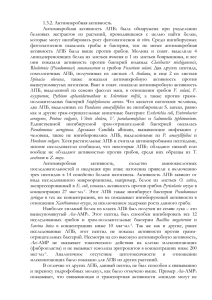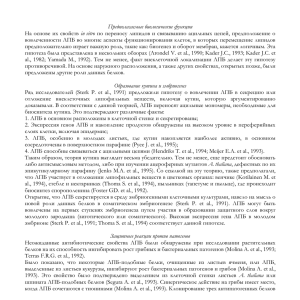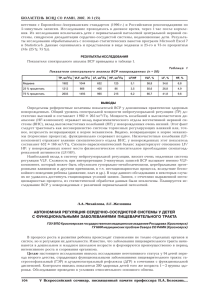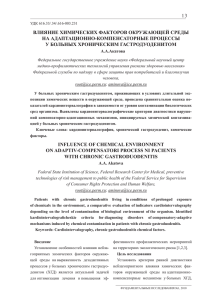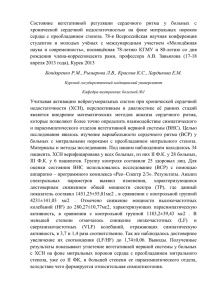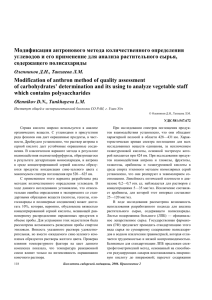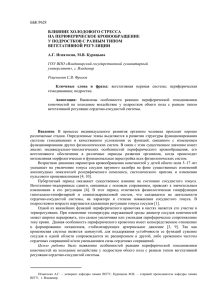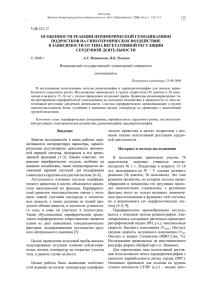ЛПБ как модуляторы роста и развития растений
реклама
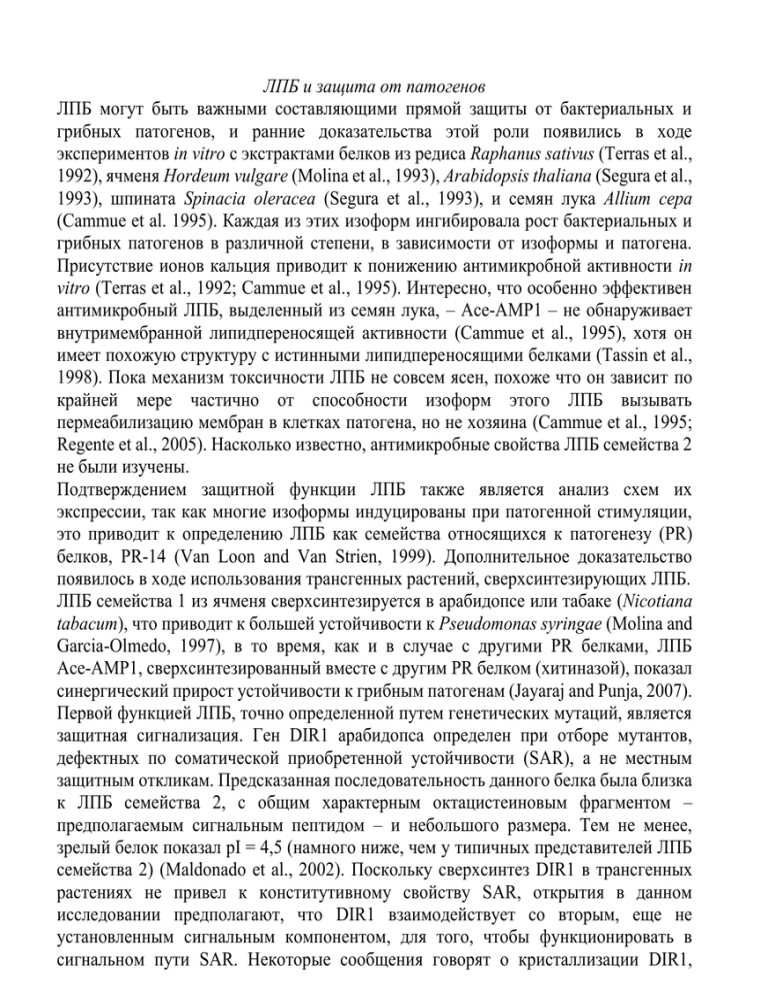
ЛПБ и защита от патогенов ЛПБ могут быть важными составляющими прямой защиты от бактериальных и грибных патогенов, и ранние доказательства этой роли появились в ходе экспериментов in vitro с экстрактами белков из редиса Raphanus sativus (Terras et al., 1992), ячменя Hordeum vulgare (Molina et al., 1993), Arabidopsis thaliana (Segura et al., 1993), шпината Spinacia oleracea (Segura et al., 1993), и семян лука Allium cepa (Cammue et al. 1995). Каждая из этих изоформ ингибировала рост бактериальных и грибных патогенов в различной степени, в зависимости от изоформы и патогена. Присутствие ионов кальция приводит к понижению антимикробной активности in vitro (Terras et al., 1992; Cammue et al., 1995). Интересно, что особенно эффективен антимикробный ЛПБ, выделенный из семян лука, – Ace-AMP1 – не обнаруживает внутримембранной липидпереносящей активности (Cammue et al., 1995), хотя он имеет похожую структуру с истинными липидпереносящими белками (Tassin et al., 1998). Пока механизм токсичности ЛПБ не совсем ясен, похоже что он зависит по крайней мере частично от способности изоформ этого ЛПБ вызывать пермеабилизацию мембран в клетках патогена, но не хозяина (Cammue et al., 1995; Regente et al., 2005). Насколько известно, антимикробные свойства ЛПБ семейства 2 не были изучены. Подтверждением защитной функции ЛПБ также является анализ схем их экспрессии, так как многие изоформы индуцированы при патогенной стимуляции, это приводит к определению ЛПБ как семейства относящихся к патогенезу (PR) белков, PR-14 (Van Loon and Van Strien, 1999). Дополнительное доказательство появилось в ходе использования трансгенных растений, сверхсинтезирующих ЛПБ. ЛПБ семейства 1 из ячменя сверхсинтезируется в арабидопсе или табаке (Nicotiana tabacum), что приводит к большей устойчивости к Pseudomonas syringae (Molina and Garcia-Olmedo, 1997), в то время, как и в случае с другими PR белками, ЛПБ Ace-AMP1, сверхсинтезированный вместе с другим PR белком (хитиназой), показал синергический прирост устойчивости к грибным патогенам (Jayaraj and Punja, 2007). Первой функцией ЛПБ, точно определенной путем генетических мутаций, является защитная сигнализация. Ген DIR1 арабидопса определен при отборе мутантов, дефектных по соматической приобретенной устойчивости (SAR), а не местным защитным откликам. Предсказанная последовательность данного белка была близка к ЛПБ семейства 2, с общим характерным октацистеиновым фрагментом – предполагаемым сигнальным пептидом – и небольшого размера. Тем не менее, зрелый белок показал pI = 4,5 (намного ниже, чем у типичных представителей ЛПБ семейства 2) (Maldonado et al., 2002). Поскольку сверхсинтез DIR1 в трансгенных растениях не привел к конститутивному свойству SAR, открытия в данном исследовании предполагают, что DIR1 взаимодействует со вторым, еще не установленным сигнальным компонентом, для того, чтобы функционировать в сигнальном пути SAR. Некоторые сообщения говорят о кристаллизации DIR1, таким образом его структура была точно установлена (Lascombe et al., 2006). Доказательство того, что ЛПБ семейства 1 также вовлечены в защитные сигнальные механизмы, происходит из работ, показавших, что ЛПБ1 из пшеницы способен конкурировать за участок высокого сродства к рецептору в клетках табака, содержащий элицитин – раздражитель белковой природы из оомицет, вызывающий защитный ответ (Buhot et al., 2001). Позже было показано, что ЛПБ семейства 1 из табака способны действовать подобным образом в качестве конкурирующего агента, и что сила такого взаимодействия увеличивалась, когда ЛПБ использовали вместе с фитогормонжасмоникацидом. Еще позже обработка растений этим комплексом приводила к повышению устойчивости к оомицетам Phytophthora parasitica (Buhot et al., 2004). Таким образом, в результате этих экспериментов можно сделать вывод, что ЛПБ семейства 1 и элицитин воздействуют на один, еще неустановленный рецептор с целью регуляции защитного ответа растения. Следующим доказательством, подтверждающим роль в сигнализации, являются сообщения о том, что некоторые ЛПБ1 способны связывать калмодулин, хотя и вне зависимости от кальция (Liu et al., 2001; Wang et al., 2005), и посредством недавней характеристики ковалентно модифицированной формы ЛПБ1b, обнаруженной в семени ячменя. Бакан и соавт. (2006) доказали, что ЛПБ1b содержит оксида аллена, который специфически присоединяется к ячменному ЛПБ1 по Асп7 посредством действия 9-липоксигеназы и алленоксидсинтазы. Сходство структуры такого соединения с предшественниками жасмоновой кислоты означает его функцию в сигнализации, хотя роль в улавливании токсичных оксилипинов также возможна. Стоит отметить, что присоединение оксилипина маловероятно является универсальным свойством растительных ЛПБ, поскольку Асп7 не достаточно характерен семейству ЛПБ1. Функция ЛПБ в синтезе кутикул Воздушные органы всех земных растений включаются в общее понятие структуры кутикулы, состоящей из кутина – полиэфира гидроксижирных кислот (Heredia, 2003) и множества растворимых органических соединений с высокой температурой плавления, которые в общем упоминаются как парафины (Jetter et al., 2006). На этапе, когда липидные предшественники кутикул синтезированы в клетках эпидермиса и должны преодолеть гидрофильную клеточную стенку к строящейся кутикуле, ЛПБ предполагались переносчиками этих соединений. Пока не было получено прямых доказательств этой роли ЛПБ, но экспрессия семейства 1 в эпидермисе (Sterk et al., 1991; Pyee and Kolattukudy, 1995; Suh et al., 2005) и сопоставление транспорта парафина с сверхсинтезом ЛПБ (Hollenbach et al., 1997; Cameron et al., 2006) подтверждают данную гипотезу. Для ЛПБ1 было показано in vitro соединение с ацил-СоА, но не было доказано реакции с предсказанными гидроксиацил-СоА предшественниками кутина или очень длинными цепями алифатических соединений парафинов. Была также предложена альтернативная модель ЛПБ как структурного компонента кутикул, в которой ЛПБ соединяется с двумя частями из соседних доменов кутина, образуя при этом нековалентные мостики (Renan et al., 2003). ЛПБ как модуляторы роста и развития растений Также сообщается, что ЛПБ вовлечены в репродуктивный и вегетативный рост и развитие. ЛПБ семейства 1 из стебля лилии (SCA) были очищены, и показано, что они необходимы наряду с пектиновыми полисахаридами для адгезии к пыльцевой трубке синтетического стебелькового матрикса (Park et al., 2000; Park and Lord, 2003). Более того, когда экспрессия ортологичных генов AtLTP3 и AtLTP4 была подавлена в трансгенном Арабидопсе, наблюдались дефекты как в вегетативном, так и в репродуктивном росте, так полученные растения были карликовыми, со стерильными пыльниками и практически стерильными пестиками при опылении пыльцой дикого типа (K. Chae and E.M. Lord, pers. comm.). Интересным и неожиданным открытием стало то, что ЛПБ1 способны активизировать разрушение растительной клеточной стенки, и поэтому могут играть роль в увеличении клеток и росте растения. ЛПБ1, выделенные из эксудата рыльца табака, как было показано, вызывают натяжение клеточной стенки при напряжении. Это свойство ЛПБ обнаруживается общим у семейства 1, поскольку схожие результаты дает и ЛПБ из пшеницы. Механизм данного действия не ясен, хотя похоже, что он зависит от доступности гидрофобных участков в ЛПБ (Nieuwland et al., 2005). В общем, хотя и достигнут большой прогресс как в изучении биохимии ЛПБ, так биологии, остается значительная брешь в понимании строения ЛПБ и его функций in vivo. Их сродство к липидам − предположительно основа их биологической функции, но множество важных вопросов еще останутся до тех пор, пока in vivo субстраты не будут точно установлены. Эволюция генов и ЛПБ-подобные последовательности ЛПБ впервые были определены через анализ биохимической активности, но из расшифрованного полного генома растений стало очевидно, что два биохимически установленных семейства липидпереносящих белков обширные, и что существуют дополнительно последовательности аминокислот, обладающие некоторыми характеристиками "настоящих" ЛПБ. Октацистеиновый фрагмент, характерный для ЛПБ, также обнаружен в растительных 2S-альбуминах, некоторых ингибиторах протеаз и гибридных белках, богатых пролином (Jose-Estanyol et al., 2004). В 2003 году исследование генов A. thaliana, которые могут быть вовлечены в ацил-липидный метаболизм (Beisson et al., 2003), обнаружило 71 ЛПБ-подобную последовательность на основе сохраненного октацистеинового фрагмента. Тем не менее, более поздний анализ генома арабидопса показал, что в прошлом маленькие богатые цистеином пептиды, такие как ЛПБ, были предсказаны в попытках описания генома (Silverstein et al., 2007). С доступностью полных последовательностей геномов некоторых видов растений стало возможным теперь проанализировать распространенность ЛПБ по всему царству растений. В трех видах покрытосеменных, для которых доступны полные последовательности геномов (рис, арабидопс, тополь), обнаружена приблизительно дюжина генов ЛПБ1 в каждом из геномов, в то время как последовательности с четкой гомологией с ЛПБ семейства 1 также присутствуют и у голосеменных растений, как следует из последовательностей EST у сосны Pinus taeda и других видов. Тем не менее, исследования BLAST проектов геномов мха Physcomitrella patens и плауна Selaginella moellendorffii показали отсутствие последовательностей ЛПБ1. Подобное филогенетическое распределение наблюдается и для ЛПБ семейства 2, следовательно, оба семейства ЛПБ доказали свою принадлежность семенным растениям и отсутствие у низших растений. Выводы Растительные ЛПБ представляют собой тот случай, когда понимание биохимической функции класса белка и его связь со строением относительно сложны, наряду с тем, что равноценное знание их in vivo функций остается труднопостижимым. Как следствие наличия различного качества доказательств об избыточном количестве разных функций, становится вероятным предположение о наличии нескольких функций ЛПБ в живых системах, которые в общем можно допустить. Скорее всего, индивидуальные изоформы играют специфические или множественные биологические роли. Филогенетическое распределение двух биохимически охарактеризованных семейств ЛПБ предполагает, что липидпереносящие белки присутствуют исключительно у высших растений, но сам по себе этот факт не столь информативен, поскольку понимание биохимии и молекулярной биологии растений уже склоняет в этом вопросе к высшим растениям. Брешь присутствует в биохимической характеристике менее часто встречающихся изоформ ЛПБ и ЛПБ-подобных белков, и подтверждении функций in vivo, особенно вследствие генетических фенотипов, приписываемых генам ЛПБ. LTPs and defense against pathogens LTPs may be important components of direct defense against bacterial and fungal pathogens, and early evidence of this role came from in vitro screens of protein extracts from radish (Raphanus sativus) (Terras et al. 1992), barley (Hordeum vulgare) (Molina et al. 1993), Arabidopsis thaliana (Segura et al. 1993), spinach (Spinacia oleracea) (Segura et al. 1993), and onion (Allium cepa) seeds (Cammue et al. 1995). Each of these isoforms inhibited growth of bacterial and fungal pathogens to varying degrees, depending on the isoform and the pathogen. The presence of calcium ions leads to a decrease in the antimicrobial effectiveness in vitro (Terras et al. 1992; Cammue et al. 1995). Curiously, an especially effective antimicrobial LTP isolated from onion seeds, Ace-AMP1, had no detectable inter-membrane lipid transfer activity, (Cammue et al. 1995), although it possesses a similar structure to the ‘‘true’’ LTPs (Tassin et al. 1998). While the mechanism of LTP toxicity is not entirely clear, it appears that it depends at least in part on the ability of these LTP isoforms to promote membrane permeabilization in pathogen, but not host, cells (Cammue et al. 1995; Regente et al. 2005). To our knowledge, the antimicrobial properties of family 2 LTPs have not been reported. Support for a defensive role of LTPs also comes from analysis of their expression patterns, since many isoforms are induced upon pathogen challenge, thus leading to the definition of LTPs as a family of pathogenesis-related (PR) proteins, PR-14 (Van Loon and Van Strien 1999). Additional evidence has been provided through use of transgenic plants overexpressing LTPs. A barley family 1 LTP overexpressed in Arabidopsis or tobacco (Nicotiana tabacum) led to enhanced resistance to Pseudomonas syringae (Molina and Garcia-Olmedo 1997), while, as is the case for other PR proteins, the Ace-AMP1 LTP overexpressed in combination with another PR protein (a chitinase) showed synergistic enhancement of resistance to fungal pathogens (Jayaraj and Punja 2007). The first function for an LTP protein clearly defined by a genetic lesion was a role in defensive signaling. The DIR1 gene of Arabidopsis was identified in a screen for mutants that were deficient in systemic acquired resistance (SAR), but not local defense responses. The predicted sequence of this protein has some similarity to family 2 LTPs, sharing such features as the eight-cysteine motif, a predicted signal peptide, and small size. However, the mature peptide has a pI of 4.5, which is much lower than is typical for family 2 LTPs (Maldonado et al. 2002). Since overexpression of DIR1 in transgenic plants did not lead to constitutive SAR, the investigators of this study proposed that DIR1 interacts with a second, unidentified signaling component in order to function in the SAR signaling pathway. The crystallization of DIR1 has been reported, and its structure is currently being solved (Lascombe et al. 2006). Evidence that family 1 LTPs are also involved in defensive signaling came from studies showing that wheat LTP1 can compete for a high affinity receptor binding site in tobacco cells, with elicitin, a defense response inducing elicitor protein from oomycetes (Buhot et al. 2001). Later it was shown that a family 1 tobacco LTP could similarly act as a binding competitor and that the strength of this interaction was increased by LTP in complex with the phytohormonejasmonicacid. Furthermore, treatment of plants with this complex lead to increased resistance against the oomycete Phytophthora parasitica (Buhot et al. 2004). Thus, it appears that, in this case, a family 1 LTP and elicitin act on the same, currently unidentified, receptor in order to modulate plant defense responses. Further evidence corroborating a role in signaling comes from reports that several family 1 LTPs can bind calmodulin, albeit in a calcium-independent manner (Liu et al. 2001; Wang et al. 2005), and by the recent characterization of a covalently modified form of LTP1 (LTP1b) that has been observed in barley seeds. Bakan et al. (2006) demonstrated that the LTP1b consisted of an allene oxide that is specifically adducted to barley LTP1 at Asp7 by the action of 9-lipoxygenase and allene oxide synthase. The similarity of the adduct structure to precursors of jasmonic acid suggests a role in signaling, although a role in trapping of toxic oxylipins may also be possible. It should be noted that oxylipin adduction is not likely a universal feature of plant LTPs as Asp7 is not well conserved in the LTP1 family (see Fig. 1C). LTP function in cuticle synthesis The aerial organs of all land plants are covered with a structure, termed the cuticle, consisting of cutin, a polyester of hydroxy-fatty acids (Heredia 2003), and a variety of high melting point organic soluble compounds that are generically referred to as waxes (Jetter et al. 2006). Since the lipid precursors of the cuticle are synthesized within epidermal cells and must pass through the hydrophilic cell wall to the developing cuticle, LTPs have been proposed as carriers of these compounds. While no direct evidence has been produced for this role, theexpressionof family1LTPsinthe epidermis(Sterk et al. 1991; Pyee and Kolattukudy 1995; Suh et al. 2005) and the correlation of wax accumulation with increased LTP expression (Hollenbach et al. 1997; Cameron et al. 2006) support this hypothesis. In vitro binding of acyl-CoA has been shown for family 1 LTPs (see above), but binding of the predicted hydroxyacyl-CoA precursors of cutin, or the very-long chain aliphatic compounds of waxes, has not been demonstrated. An alternative model for LTPs as structural components of the cuticle has also been proposed, in which an LTP binds two acyl moieties from neighboring cutin domains in order to form non-covalent bridges (Renan et al. 2003). LTPs as modulators of plant growth and development LTPs are also purported to be involved in reproductive and vegetative growth and development. A family 1 LTP from lily styles (SCA) was purified and shown to be necessary, along with pectin polysaccharides, for pollen tube adhesion on an artificial stylar matrix (Park et al. 2000; Park and Lord 2003). Moreover, when the expression of orthologous AtLTP3 and AtLTP4 genes was reduced in transgenic Arabidopsis, defects in both vegetative and reproductive growth were seen, since the resulting plants were dwarfed, with sterile anthers and semi-sterile pistils when pollinated with wild-type pollen (K. Chae and E.M. Lord, pers. comm.). An interesting and unexpected finding was that family 1 LTPs can promote plant cell wall loosening and thus may play a role in cell expansion and plant growth. A family 1 LTP isolated from tobacco stigma exudate was shown to promote extension in cell walls under tension. This appears to be a general property of family 1 LTPs, as a family 1 LTP from wheat showed a similar effect. The mechanism of action is not clear, although it appears to depend on the availability of the hydrophobic cavity of LTPs (Nieuwland et al. 2005). In general, although there has been significant progress in both the study of LTP biochemistry and biology, there remains a significant gap between the understanding of LTP structure and proposed functions in vivo. Their affinity for lipids is presumably fundamental to their biological function, but many critical questions will remain until in vivo substrates are clearly identified. Gene evolution and LTP-like sequences LTPs were first identified through assaying a biochemical activity, but it is clear from the analysis of completed plant genomes that the two biochemically characterized families are large and that there are additional sequences that share some characteristics with these ‘‘true’’ LTPs. The eight-cysteine motif that is typical of LTPs is also found in plant 2S-albumins, some protease inhibitors, and hybrid proline-rich proteins (Jose-Estanyol et al. 2004). In a 2003 survey of A. thaliana genes that may be involved in acyl lipid metabolism, Beisson et al. (2003) identified 71 LTP-like sequences on the basis of the conserved eight-cysteine motif. However, a more recent analysis of the Arabidopsis genome has shown that in the past, small cysteine-rich peptides, such as LTPs, have been underpredicted in genome annotation efforts (Silverstein et al. 2007). With the availability of complete genome sequences from several plant species, it is now possible to investigate how LTPs are distributed throughout the plant kingdom. In the three angiosperm species for which full genome sequence is available (rice, Arabidopsis,and poplar) approximately a dozen family 1 LTP genes are present in each genome, while sequences with clear homology with family 1 LTPs are also present in the gymnosperms, as seen from EST sequences in pine (Pinus taeda) and other species. However, BLAST searches of current Physcomitrella patens (a moss) and Selaginella moellendorffii (a lycophyte) genome drafts shows no family 1 LTP sequences. A similar phylogenetic distribution is seen for the family 2 LTPs, and so, both family 1 and family 2 LTPs appear to be restricted to seed plants and absent in lower plants. Conclusions Plant LTPs represent a case where an understanding of the biochemical activity of a protein class and its association with structure is relatively sophisticated, while equivalent knowledge of in vivo function remains elusive. With evidence of varying quality for a plethora of different functions, it seems likely that there is not a single function that can be assigned to LTPs in general. Rather, individual isoforms likely play specific or multiple biological roles. The phylogenetic distribution of the two biochemically characterized LTP families suggests that they are unique to higher plants, but this in itself is not particularly informative, as the understanding of plant biochemistry and molecular biology is also biased toward higher plants. What is lacking is biochemical characterization of the less abundant isoforms of LTPs, and LTP-like proteins, and in vivo confirmation of function, especially through genetic phenotypes that can be ascribed to LTP genes.
